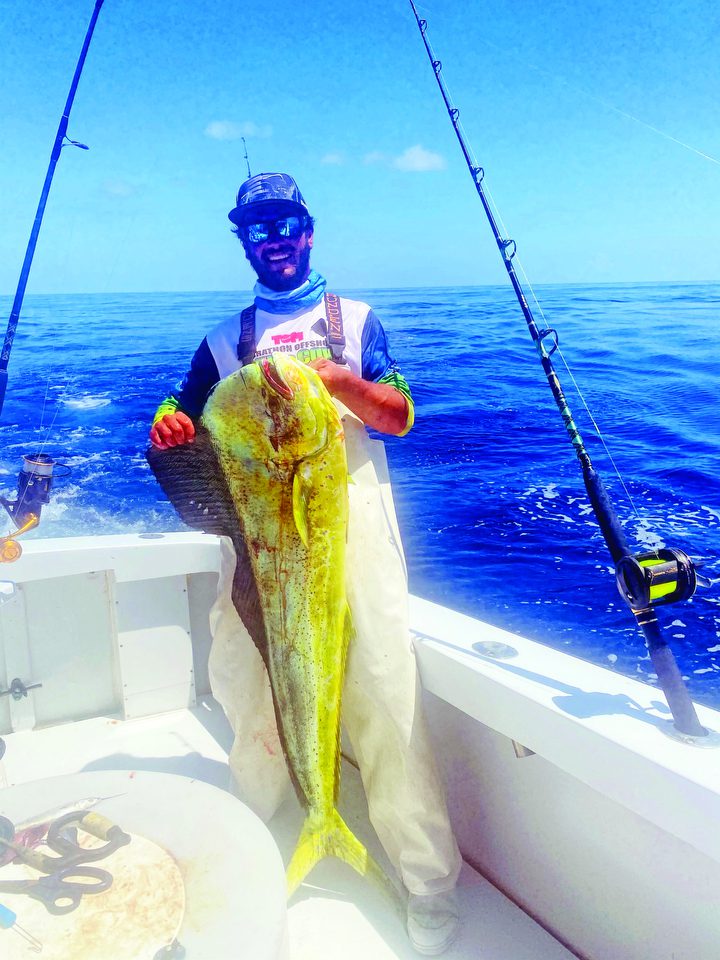By Capt. Quinlyn Haddon
Mahi fishing can be tricky in some places and times of year. They congregate under floating material adrift in the current, leaving them with no fixed address within an area of greatly variable depths.
If you are fortunate enough to be able to target dolphinfish along the Gulf Stream this summer, you are in the right place at the right time. You shouldn’t have much trouble filling your cooler and even maxing out on the generous daily bag limit of this species.
Head out to target mahi with a full tank of fuel. Assume you will have to run far and wide to find them, but hope to get lucky along the way. Recruit everyone on board to remain on the look out for the three telltale mahi hangouts: weeds, birds and floaters.
Weeds can be productive whether they are formed tightly in a line, or even a tight patch.
Birds can be a great sign of actively feeding fish at the surface, but they can also just be birds being birds. Learn to read them properly to avoid wasting time. A group of circling birds or diving birds is what you want to look for, and the more the better. Sometimes, a bird that’s on fish will flicker in the sun, reflecting the sunlight in a sporadic pattern as it moves its body to stay on top of something it has spotted under the surface. Circling frigate birds are always a good sign. If you see one even attempt a dive, start trolling immediately.
Floaters can be anything floating in the water, from debris to sea turtles. When you find floaters in open water, it doesn’t take long to feel out if it is productive or not.
If you happen to see all three of these goldmines come together, with birds diving around debris sucked to a weedline, troll the ever loving shi…mano out of it.
When trolling for mahi, you won’t need to run more than four lines. Troll two small lures long, ideally on the outriggers, to draw in smaller dolphin. Troll one medium lure or ballyhoo at mid-length, and one large lure close.
Dolphinfish have the mentality of a toddler. When you reel one to the boat, leave the fish in the water, put your rod in the rod holder, and cast out behind the hooked fish. The school should have followed your mahi to the boat, and with their mahi-see, mahi-do mentality, they’ll all want to partake in snack time. Continue hooking mahi and leave them in the water until you run out of available rods to cast.
Start by putting one fish in the boat, but don’t take the second out of the water until the first rod has gone back out and hooked another fish. Try switching from live bait to chunk bait to keep them eating. If they don’t slam a bait as soon as it hits the water, try twitching the bait. Even a completely healthy and well-presented live bait sometimes isn’t as enticing as one that’s getting yanked away from them.
Mahi will eat nearly anything, especially if you know how to taunt them properly. One of the biggest challenges in catching them is trolling through weeds. Weeds that cling to your lures is a pain to manage on the deck, while constantly clearing lines, and you also miss a lot of opportunities to catch fish. All lures catch weeds, the determining factor is whether they shed those weeds. Deep diving lures that never breach the surface are not your friend in this situation. Lightweight, squid-skirted lures do an excellent job of popping out of the water when bogged down with weeds. Most times, they clear themselves of weeds.
Blue Magic Charters makes their own 3D-printed lures designed to troll in weeds. Visit them in Marathon, Fla., and ask us about their DR. BUBBLES lures.
Capt. Quinlyn Haddon fishes with Blue Magic Charters in Marathon, Fla. Contact her at (504) 920-6342 and visit CaptainQuinlyn.com.



